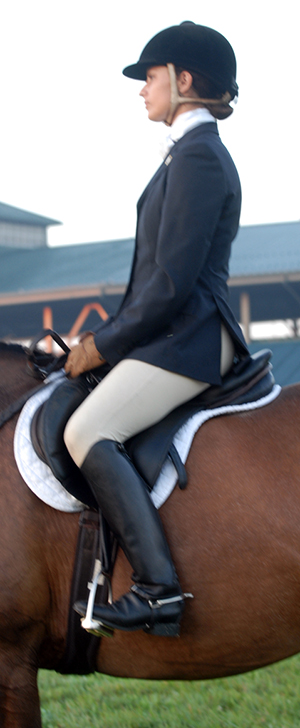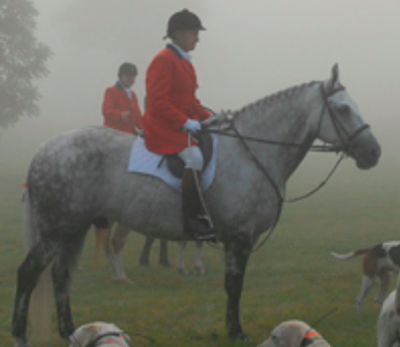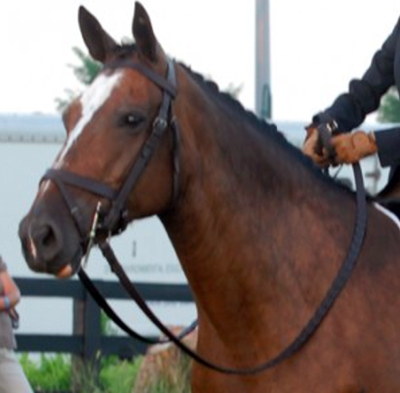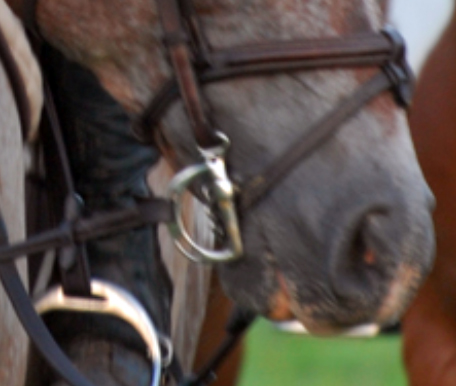Whys and Wherefores of Foxhunting Tack Traditions
written by Nancy Ambrosiano
photos from United States Pony Club
If you are an occasional visitor to your local hunt, you probably don’t need to worry too much about the specific tack you’re using, other than having it all clean, safe, well fitted and with enough brakes to keep your horse in the field.
But if you’ve been reading the Rita Mae Brown foxhunting mysteries, or you know someone who hunts regularly, you’ll note that there are some items of equipment that are more “correct” than others. It’s a matter of tradition, gently blended with what’s useful and sensible.
.jpg)
Traditional Hunting Tack.
First, consider that a hunt, unlike a schooling session, can involve hours (3 or 4 or more) out in the open. It’s in the winter, and can involve hills, creeks, trees, cactus, branches, brambles, sand, mud, even roadways. The rate of speed, depending on your preference and in which field you ride, varies from standing quietly to full-on galloping and jumping. So every item of equipment needs to be picked for maximum utility. This is not your average arena ride or cross country schooling round.
Saddles: Some may choose to hunt in a dressage, Australian or even Western saddle, especially if they’re in second field, hunting once a year, and not jumping or galloping hard.
But the tradition is for a jumping or all-purpose saddle that fits the horse really well, nicely up off the withers, not pressing into the shoulders or bridging the back to cause pressure spots. Some riders prefer a really soft seat, such as an Albion, but others are happy with old-fashioned Stubbens that can be pretty hard. The key is that jump-saddle knee rolls and calf blocks can give you an extra degree of security. Black or brown? Traditionalists would go with brown for all tack, as black really only popped up in the fashion scene when dressage saddles went that direction, and lots of synthetics come in black as well. It’s not really a hunting thing. Your first priority, however, is that it fits your horse for the hours in which you’ll be out there.

Appropriate Hunt Saddle and Saddle Pad.
Saddle pads: In the hunt field, as in the hunter ring, a fitted or shaped pad is correct. Cream, white or even canary yellow sheepskin or artificial fleece, shaped the same as the saddle. Not a big dressage square or a colorful eventing cross country pad. If you choose to add a Mattes, ThinLine or other therapy pad that’s just fine, if that’s what your horse needs to be comfortable.
Girths: These are very much a matter between you and your horse, no one’s going to look that closely. Be alert to any signs of rubbing, swelling or girth galls, as hours in the tack will have an effect very different from your usual arena session. On weekends when I’m hunting one day and trail riding or schooling the next, I switch girths to be sure the same pressure points are not being stressed or rubbed both days.
Breastplates & Martingales: A traditional hunting breastplate serves to keep the saddle from shifting back in long uphill gallops, crossing arroyos or climbing out of ditches. It also gives you a grab-strap for the occasional steep hill, big jump or bucking fit. Fitted with four fingers’ space at the shoulder and under the chest, it connects from the saddle’s upper D rings (or Dee Savers), meets in a V at the chest, and has a center strap to the girth. If your horse might toss his head a bit, either a standing or running martingale can be attached. Some traditionalists insist that only a standing is the most correct martingale, and that running martingales’ rings can get caught in tree branches and cause a wreck. On the other hand, a standing martingale must be adjusted correctly to allow freedom of movement climbing and jumping in hunt territory: you don’t want to tie your horse’s head down to force him to fall at a big fence, or hold his head down below water height if he’s crossing a river. Attach the standing to the breastplate and the cavesson, then be sure you can lift the slack into the angle between the horse’s head and neck. Not too loose, or it’s pointless. Just tight enough that it keeps their ears from going up your nose during a rowdy moment.

Hunt breastplate and martingale.
There are lots of other kinds of things to stabilize your saddle, such as elastic breast girths, polo breast collars, and eventing 5-point breastplates, and you can use whichever you have that works for your horse, but the most classic is the plain hunting breastplate.
Bridles: This is where the fashionistas in the hunt field can accidentally stick out like a sore thumb. With dressage and eventing bridles adding bling, and endurance and trail folks going for artificial products that convert to halters, there are many options that can lead you off the traditional hunt-tack path.

Hunt Bridle.
If you are fortunate enough to be choosing new or used tack for the hunt field, the key is PLAIN. And brown. And clean. Flat, wide cavessons with simple, flat (not raised, twisted, braided or blinged) browbands, are the norm. If your horse’s circumstances require a flash attachment or a gag bit with running cheekpieces, that’s fine, but if you’re starting simply, keep it classic. And keep in mind, if your stopping ability requires the need to strap on a flash and crank it tight, that’s going to be quite stressful for your horse to wear hour after hour. Look for options such as a different bit, if possible. And if you’d like to be really, really elegant, your bridle is custom fitted to your horse, with the reins and cheekpieces sewn to the bit, no buckles!
Bits: Oh, what a Pandora’s Box of choices! The classic concept is that a nice horse might hunt quietly in a plain snaffle. And indeed, many quiet horses go well in a snaffle or even a bitless bridle. Many, many nice horses, however, get their adrenalin levels up out hunting and some additional braking capability is a matter of safety for you and those around you! Learn to ride with double reins so you can use a Pelham, and then your snaffle rein is the main rein, and the curb rein comes into use only when essential during a sudden “hold hard” stop.

Kimberwick bit.
If that’s too confusing, a Kimberwicke can be a nice choice, as you can tighten or loosen the curb chain to match your horse’s needs and comfort level. Many long-time horsemen prefer to keep the mouthpiece choices smooth, not twisted or edged, since the long gallops of a hunt require a horse to be able to lean into the bit without incurring bruising or discomfort. Oh, and another handy point of the double reins on a Pelham is that should someone in the field break a rein, you have a spare rein to offer them.
Galloping boots: If your horse does not normally interfere, and has no old bows or injuries that need protection, you can skip the boots. The hours spent out hunting can involve more dirt, water, sand, mud and work time than boots are really designed to handle. Galloping boots and even just ankle boots or bell boots can chafe a leg badly in the course of a hunt, and wearing that neoprene, plastic, etc. for hours will add a lot of heat to an already hard-working tendon structure. Leave the boots at home if you possibly can. If your horse needs to have an injury protected, or smacks himself, then of course the boots are a necessary item, preferably in plain brown or black.
So that’s the scoop — and of course, you can always ask your hunt’s Honorary Secretary or Master of Foxhounds about the local preferences. As a guest, you can usually get away with almost anything, but if you take this up as your newfound favorite sport, it is just lovely to appear with a really correct turnout, and it might help you enjoy each day a bit more.
Tally Ho!
About the author: Nancy Ambrosiano is a foxhunter and United States Pony Club graduate currently living in the mountains outside Santa Fe, New Mexico. She grew up hunting with Princess Anne Hunt in Virginia, and now is president and field master of Caza Ladron Hunt in Santa Fe. When she is not hunting, she is a science writer for Los Alamos National Laboratory.




